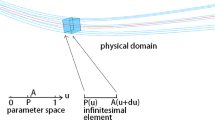Abstract
In this paper, a boundary element method is first applied to real-time animation of deformable objects and to simplify data preparation. Next, the visible external surface of the object in deforming process is represented by B-spline surface, whose control points are embedded in dynamic equations of BEM. Finally, the above method is applied to anatomical simulation. A pituitary model in human brain, which is reconstructed from a set of anatomical sections, is selected to be the deformable object under action of virtual tool such as scalpel or probe. It produces fair graphic realism and high speed performance. The results show that BEM not only has less computational expense than FEM, but also is convenient to combine with the 3D reconstruction and surface modeling as it enables the reduction of the dimensionality of the problem by one.
Similar content being viewed by others
Explore related subjects
Discover the latest articles, news and stories from top researchers in related subjects.References
Boulic Ret al. The HUMANOID environment for interactive animation of multiple deformation human characters. InEurographics’95, 1995, 14(3): 338–348.
Yuencheng Lee, Terzopoulos D, Waters Keith. REalistic modeling for facial animation. InSIGGRAPH’95 Proc., Los Angeles, CA, Aug. 1995, pp. 55–62.
Pascal Volino, Martin Courchesne, Thalmann M. Versatile and efficient techniques for simulating cloth and other deformable objects. InSIGGRAPH’95 Proc., Los Angeles, CA, Aug. 1995, pp. 137–144.
Marie-Paule Gascuel. An implicit formulation for precise contact modeling between flexible solids. InSIGGRAPH’93 Proc., Anaheim, CA, Aug. 1993, pp. 313–320.
Terzopoulos D, Hong Qin. Dynamic NURBS with geometric contains for interactive sculpting.ACM Trans. on Graphics, 1994, 13(2): 103–136.
George Celniker, Dave Gossard. Deformable curve and surface finite-elements for free-form shape design.Computer Graphics, 1991, 25(4): 257–266.
Jeffrey A. Thingvold, Elaine Cohen P. Physical modeling with B-spline surface for interactive design and animation.Computer Graphics, 1990, 24(2): 129–137.
William Welch, Andrew Witkin. Variational surface modeling.Computer Graphics, 1992, 26(2).
David T Chen, David Zeltzer. Pump it up: Computer animation of a biomechanically based model of muscle using the finite element method. InSIGGRAPH’92, Chicago, July 1992, pp. 89–98.
Mark A Sagaret al. A virtual environment and model of the eye for surgical simulation. InSIGGRAPH’94, Orlando, July 1994, pp. 205–212.
Demetri Terzppoulos, John Platt, Alan Barr Kurt Fleischer. Elastically deformable models.Computer Graphics, 1987, 21(4): 205–214.
Demetri Terzopoulos, Alan Barr Kurt Fleischer. Modeling inelastic deformation: Viscoelasticity, plasticity, fracture.Computer Graphics, 1988, 22(4): 269–278.
Zienkiewicz. The Finite Element Method, third edition. McGraw-Hill Book Co., U.K., 1977.
Banerjeeet al. Transient elastodynamic analysis of 3D problems by boundary element method.Earthquake Engng. Struct. Dyn., 1986, Vol. 14.
Manolis G Det al. A comparative study on three boundary element method approaches to problems in elastodynamics.Int. J. Num. Math. Engng., 1983, 19: 73–91.
Piper B. Visually smooth interpolation with triangular Bezier patches. InGeometric Modeling: Algorithms and New Trends, Farin G (ed.), Society for Industrial and Applied Mathematics, Philadelphia, 1987, pp. 221–233
Fung Y C. Biomechanics: Mechanical Properties of Biological Materials. Springer-Verlag, New York, 1981.
Meihe Xu, Zesheng Tang, Junhui Deng. A new algorithm for contours-connection. InThe Fourth Int’l Conf. on CAD/CG, Wuhan, China, Oct. 22–25, 1995, pp. 468–475.
David R Forseyet al. Surface fitting with hierarchical splines.ACM Trans. on Graphics, 1995, 14(2): 134–161.
Meihe Xu, Zesheng Tang, Junhui Deng. A B-spline surface interpolation technique for reconstructing 3D objects from serial arbitrary shaped plannar contours. InThe Third Int’l Computer Science. Conf., ICSC’95, Hong Kong, Dec., 1995, Springer, pp. 74–82.
Lorensen W E, Cline H E. Marching cubes: A high resolution 3D surface construction algorithm.ACM Computer Graphics, 1987, 21(4): 163–169.
Hugues Hoppe, Tony Derose, Tom Duchamp, Mesh optimization. InSIGGRAPH’93 Proc., Anaheim, California, Aug. 1993, pp. 19–25.
Manolis G D, Beskos D E. Boundary element methods in elastodynamics. Uniwin Hyman, 1988.
Author information
Authors and Affiliations
Corresponding author
Additional information
This work was supported in part by the National Natural Science Foundation of China.
For the biographies ofXu Meihe andTang Zesheng, please refer to p. 479 of this issue.
Rights and permissions
About this article
Cite this article
Xu, M., Tang, Z. A boundary element method for simulation of deformable objects. J. of Comput. Sci. & Technol. 11, 497–506 (1996). https://doi.org/10.1007/BF02947217
Received:
Revised:
Issue Date:
DOI: https://doi.org/10.1007/BF02947217




